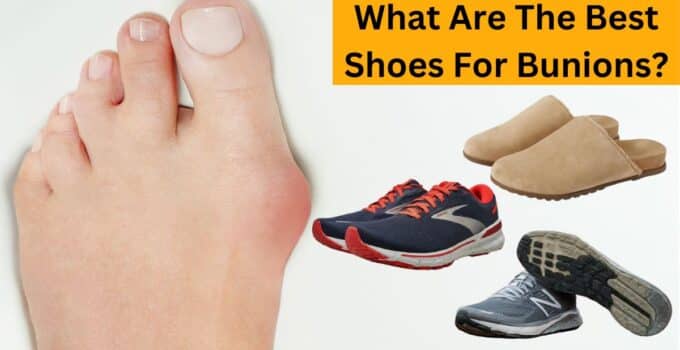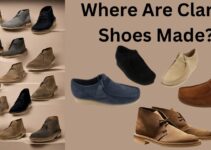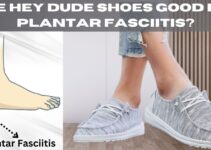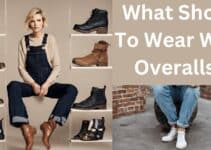Are you looking for a way out of bunion pain? That’ll be in the shoe rack. What are the best shoes for bunions? It is not simply a question. It’s the first step towards ease and movement for those against this common foot disorder. Bunions, these bumpy bones that develop on the base of your big toe, can make ordinary walking laborious. But don’t be concerned!
The proper footwear can make a lot of difference in relieving your feet and offering them space as they wish. Suppose you want to know how to spoil your feet with the perfect shoes for bunions so that each move can lead one step away from discomfort into a painless day. In that case, I advise you to continue reading this guide. Please continue reading to discover tips on wearing shoes suitable for bunion sufferers, including expert advice and tips on keeping one’s feet happy and healthy.
Essential Requirements Of Bunion Friendly Shoes
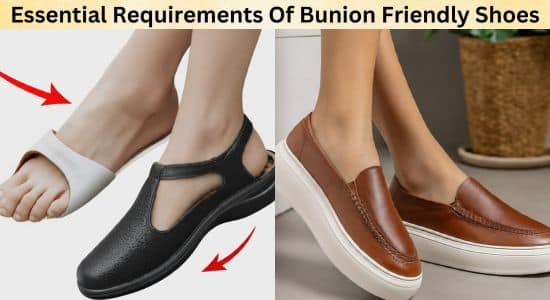
1. Wide Toe Box
The primary criterion is getting wide toe boxed shoe types. Shoes that squash your toes may worsen bunion pain or even deteriorate the condition further. Just let your toes go wild by providing enough space inside, immediately alleviating pain from pressure exerted on the lumps.
2. Arch Support
Good arch support is essential when living with bunions if you care about foot health. By having good arch support, these shoes will help distribute your weight evenly across the entire foot, thereby reducing stress around this area affected by a bunion, hence greatly relieving the pains and discomforts caused during long hours of standing or walking.
3. Comfortable Materials
Your shoes’ materials play a significant role in their comfort level. Go for soft, stretchy fabrics or leathers where possible since they adapt according to the feet’ shape without causing any rubbing or pressure points around the foot. More so, breathable materials will ensure your feet remain dry and comfortable all day.
Special Points to Note:
1. Heel Height: High-heeled shoes worsen Bunion pain, forcing the forefoot. So, if you suffer from bunions, go for low-heeled shoes with a heel height of less than 2 inches. For those still wanting a heel, it is better to go for one with a wider base for better stability.
2. Stretchable Fabrics: In such situations, shoes featuring elastic fabrics in specific areas can mold themselves perfectly around your bunion while keeping styles comfortable at the same time. These materials flex as your foot moves, thus preventing the shoe from rubbing or pressing against your bunion.
It is not only buying shoes but also paying attention to the comfort and health of your feet by focusing on these essential and special considerations. Remember, the best shoes for bunions offer a blend of support, space, and softness, creating a nurturing environment for your feet. You can kiss bunion pain goodbye and welcome comfortable steps of joy daily with the appropriate footwear.
Top Shoe Choices For Bunions: What Are The Best Shoes For Bunions?
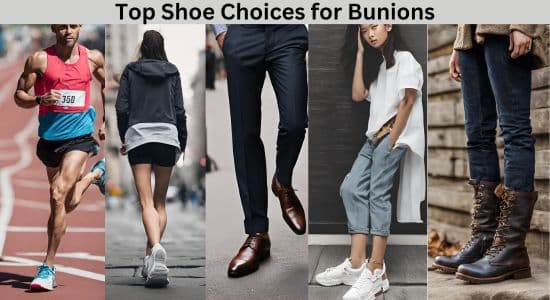
Walking Shoes
If you’re going out for a walk or running errands, walking shoes with roomy toe boxes, supportive insoles, and cushioning provide more relief than any other type of footwear. Look at models that combine flexibility and support because this would allow comfort around one’s bunion without necessarily losing balance on them’s grounds.
Running Shoes
Rejoice, runners with bunions! Many brands now offer running shoes with mesh uppers for flexibility and breathability, cushioned midsoles for shock absorption, and a wider forefoot area to reduce pressure on the bunion. These features all work together harmoniously to ensure a painless run.
Dress Shoes
Yes, you can still rock a stylish look without aggravating your bunions. Instead of pointy ones, go for dress shoes with rounded or square toes. For low-heeled options or flats, ensure they have cushions at the footbeds to keep you elegant, minus any extra strain.
Casual Sneakers and Sandals
On casual days, comfort should be essential when choosing sneakers and sandals. You should find sneakers with big-toe boxes and flexible soles. Adjustable straps in sandals can be life-changing since they help one customize their fit to accommodate bunions comfortably.
Boots for All Seasons
Don’t avoid boots if you have bunions. The most crucial factor is to search for boots with roomy toe boxes coupled with supportive soles, regardless of whether it’s autumn ankle boots or waterproof boots during snowy days, since designers have made them with happy and fashionable feet in mind.
Specialized Needs: Are there other conditions like plantar fasciitis that accompany bunions? Don’t worry about it. Some shoes consider all kinds of health issues that affect feet, including arch support where necessary and enough space inside to cater to these kinds of problems, such as growth on your foot.
Top 5 Best Shoes For Bunions Review In Video
- 1- Brooks Ghost 15 Neutral Running Shoes
- 2- Hoka Bondi 8 Max Cushioned Shoes
- 3- New Balance 880v13 Stability Shoes
- 4– Vionic Arlette Mule Slip-on Sneaker
- 5- ECCO Soft 7 Low Ankle Boot
Expert Advice and Recommendations
The choice of shoes for bunions has gone beyond immediate comfort considerations only. It considers footwear that supports the overall health of your feet. Shoes recommended by podiatrists often incorporate aspects tailored towards the alleviation of bunion discomforts as well as deformity prevention.
When picked wisely, your shoes could turn a painful experience into a pleasurable one where each step offers relaxation instead of irritation. Remember, investing in bunion-friendly footwear is investing in your mobility and quality of life. So, find the perfect pair that suits your lifestyle, and step forward confidently and comfortably.
Are you looking for the best shoes for bunions in 2024? You are on the right track. With our comprehensive look at the top picks this year, we have tested and reviewed widely so you can walk easily and style without second thoughts. Among other things, our research has enabled us to identify those bunion-friendly shoes that stand out from their competitors.
Podiatrist-Endorsed Shoe Features
Expert Insights: Podiatrists consider a few essential features when selecting shoes for bunions. A wide toe box, sufficient arch support, and materials that combine flexibility with breathability, i.e., allow air circulation across them, among others. Consequently, pressure on the bunion may be relieved, reducing inflammation while at the same time supporting the foot’s regular structure.
Why It Matters: Shoes fitting into these categories can significantly enhance daily comfort and considerably slow down bunions’ development. Buying shoes designed based on these properties demonstrates commitment towards making their feet healthier even before problems set it all together.
The Place of Insoles in the Provision of Relief for Bunions.
Custom Solutions: Custom or over-the-counter insoles are recommended by many foot doctors for a more secure feeling. These can provide cushioning and support aimed at your feet’ unique shape. The bunion sufferer insoles will spread the pressure across the foot, thus producing relief.
A Personalized Approach: Remember, what works for one person might not work for another. Seeing a podiatrist to get fitted with custom-made inserts could make all the difference you need.
Addressing Common Concerns
High Heels and Bunions: Can I wear high heels if I have bunions? This is more complex than saying yes or no. Podiatrists suggest reducing time spent wearing high-heeled shoes and choosing styles with lower heel heights and wider toe boxes when possible.
Men’s Shoes and Bunions: Male feet are also vulnerable to bunions, so it is equally important to find comfortable shoes that will not be painful. Ensure enough room in the toe area of your footwear while avoiding tight cut designs that might escalate bunion pain.
Sandals for Bunions: Yes, sandals are available for those who suffer from bunions that can accommodate them comfortably! Look out for those with adjustable straps and suitable footbeds with lots of space around their toes, allowing them to move freely.
Daily Practices For Bunion Care
Stay Active, But Be Mindful: Anyone desiring healthy feet must exercise regularly; however, it is essential to choose appropriate activities. Some low-impact exercises such as swimming, cycling, or walking do not strain your joints excessively like bunions. Ultimately, it would help if you stayed active but kept it comfortable.
Foot Stretches And Exercises: Some specific stretches and exercises can help strengthen muscles surrounding your bunion area, providing better support and reducing pain. The flexibility of your toes can be improved, and tension in the area can be relieved by toe stretches, resistance exercises, and massaging.
Proper Foot Hygiene: Never underestimate the power of good foot hygiene. Keeping feet clean and dry prevents infections that worsen bunion pain. Pay attention to the spaces between your toes when drying off after a shower, and use talcum powder if you sweat easily.
Preventing Bunion Progression
Wise Shoe Choices: As mentioned previously, getting the right shoes is essential. Choose footwear with a roomy front section, excellent arch support, and made of soft, pliable materials that do not squeeze onto your bunion but can fit well on them. The wise shoe choice is our first defense against more painful bunions.
Avoid Tight Footwear: Ill-fitting shoes, especially those with compressed toe boxes, hasten the development of corns and cause more pain to individuals with bunions. High-heeled shoes are known for worsening this condition because they exert extra pressure on the metatarsal heads, increasing forefoot angulation. Therefore, look for comfortable shoes before style comes into play.
Consider Orthotic Devices: Some people may benefit from over-the-counter or custom-made orthotics to increase support and alleviate pain. These devices work by correcting mechanical issues that contribute to bunion formation, as a result of this redistributing pressure across the foot surface while reducing stress overlying it.
Addressing Inflammation And Pain
Cold Therapy: Placing ice packs upon your bunions at the end of an arduous day can help reduce swelling and relieve pain. Remember not to apply ice directly on the skin while placing only for 20 minutes to avoid frostbite.
Remedies: temporary relief to bunion pain can be given by over-the-counter anti-inflammatory drugs. However, consulting a medical professional before commencing medication is essential to ensure it is right for you.
When should I request help from a professional?
There is a better time when all your home remedies will work, and you may need someone with experience in this field. If your bunion pain becomes severe, interferes with your daily activities, or if you notice significant changes in the shape of your foot, it’s time to consult a podiatrist. If needed, they can offer more personalized advice, treatment options, and surgeries.
Managing bunions is about balancing comfort with preventative care. Following these steps as part of your daily routine and carefully making decisions about footwear and exercise significantly improves your quality of life. In other words, taking good care of your feet means taking care of yourself holistically, enabling you to walk through life without much hindrance.
The Bunion Institute
Why You Need Professional Advice: It can be helpful, but there’s nothing like having a podiatrist give you personal advice. This is because specialists like the Bunion Institute provide customized solutions and treatment plans for your specific condition and lifestyle needs. Additionally, they may offer diagnostic insights, suggest therapeutic interventions, or even talk about surgery where necessary.
Book Your Bunion Consultation
It’s Time To Take That Step: If you have been experiencing bunion pains that seem not to go away or are growing bigger quickly, consider visiting an expert today. Scheduling an appointment with a podiatrist will be a good step in developing comprehensive strategies for treating bunions. During the visit, be ready to discuss your past health records, existing symptoms, and therapies attempted earlier on.
Real-Life Stories from Patients
Hope Gleaned from Another Journey: Sometimes, reading about the experiences of others in managing or treating bunions can be very motivating and uplifting. Patient testimonials often highlight the effectiveness of treatments, offering insights into what might work best for you.
Learn from Their Stories: Another benefit of these stories is that they help you understand different recovery processes after treatment so that you know what to expect. Understanding others’ journeys through non-surgical approaches or bunion surgery may guide you in deciding how to treat yourself.
Additional Resources and Support
Educational Materials: Look out for pamphlets, e-books, and other digital materials focusing mainly on foot health and remedial actions for bunions. Such resources can supplement your knowledge base and help you make better choices regarding treatment options.
Support Groups/Forums: Connecting with online communities or local support groups could provide emotional backup and practical tips from people who have gone through similar states before. Sharing one’s experience while learning from others can be encouraging and helpful.
Stay Ahead of Your Bunion Battle: The road to effectively manage a bunion does not stop anywhere. Keep proactive by finding expert advice and using educational resources and supportive tools. Moving forward confidently along this journey will be easier. Remember, others are traveling the same path, plus plenty of assistance is available so that together, improved walking health status may be achieved, making everyday life more comfortable.
Understanding Insoles
Targeted Support: They provide targeted support to specific parts/regions of the foot, including arches, heels, and forefoot. For people with bunions, using these inserts helps distribute pressure evenly across your feet, thus straining less on affected areas, leading to correct alignment.
Cushioning And Shock Absorption: Many insoles have soft padding or gel inserts, adding cushioning to absorb shocks, thereby increasing comfort to the wearer, especially anyone who has bunions and feels pain during longer walks or standing.
Types Of Insoles For Bunions
Over-The-Counter Insoles: These are available from any local drugstore or online retailer and come in various styles and materials. Although off-the-shelf insoles may not offer a fit as personalized as the ones fitted by a prosthesis specialist, they can still bring about significant relief and support for bunions.
Custom-Made Insoles: Custom-made insoles are made such that they fit into your unique footprint, thus providing optimum support and comfort. A podiatrist or orthopedic specialist will measure you correctly and make these inserts with all aspects of the bunion corrected.
Advantages Of Using Insoles For Bunions
Pain Relief: They can ease pain from bunions by relieving pressure on them while also providing cushioning for aching joints. This provides instant relief and hence improves overall well-being during everyday activities.
Improved Stability: By ensuring that foot alignment is more precise and balance is better distributed, these inserts increase stability, thereby reducing tripping off or falling due to discomfort from bunions.
Preventive Care: Aside from therapeutic management, the use of certain insole brands may prevent the development or worsening of bunion deformities due to faulty biomechanics. Wearing these devices helps maintain natural form, reducing excessive stress on the metatarsal area and slowing down the bunion progression.
Choosing the Right Insoles
Consider Your Needs: When buying an insert for your foot condition, consider things like harshness, how active you are, and some general foot issues one has. Discuss with a podiatrist or shoe store expert to single out the most appropriate choice explicitly catered for you.
Quality and Durability: Seek insoles made from high-quality materials for durability and lasting support. While cost is a factor, put money into getting better shoe pads that will equally impact your foot health and body wellbeing.
Bunion management tools like insoles provide pain relief, prevention, and targeted support. Whether you choose to go for over-the-counter options or have orthopedic ones, including them in your shoes can make all the difference in the world regarding how comfortable you are when walking. Understand their role and select those that fit your requirements to prevent bunions, ensuring healthier feet.
Which Shoes Do Doctors Recommend Wearing For Bunions?
Shoes for bunions are usually advised to have wide toes and solid arch support and to be made of soft materials. Brands focusing on foot health and providing elements like cushioned insoles or adjustable straps for bunion relief must be sought.
Why It Matters: Choosing the right shoes can make a big difference in controlling bunion pain and avoiding future discomforts. A podiatrist recommended footwear helps your toes grow healthy with enough support and space they need.
Should You Wear Wide Shoes if You Have Bunions?
Yes, wearing wide shoes is highly recommended for individuals with bunions. Pain from bunions may worsen over time if one opts for narrow shoes. Going instead for wider shoes allows the toes to spread naturally, minimizing pressure on the bunion and overall foot comfort.
Why It Matters: Roomy footwear relieves bunion pain without discomfort or friction. Transitioning from regular shoes to wide ones often results in immediate healing while improving long-term foot health benefits.
What Is the Cost of Quality Shoes for Bunions?
The costs of bunion shoes depend on the brand, materials, and additional features. However, while quality shoes for bunions may be priced higher than other footwear, it is worth buying them because your foot health is essential. Generally, when it comes to comfortable and supportive shoes in the long run, they are better than their initial price.
Why It Matters: Investing in quality shoes is more than just a financial investment but also an investment in overall well-being and mobility. Bearing this cost as part of your healthcare budget would mean selecting shoes that promote foot health and relieve bunion pain.
Which Shoes Are the Worst for Bunions?
Usually, the worst women’s shoes for bunions are those with tight toe boxes, high heels, or made from rigid materials that restrict foot movement. Typical women’s footwear, such as pointed-toe pumps, stilettos, and lightly cushioned shoes, is unsupportive to bunions and can worsen pain.
Why It Matters: Avoiding wearing such an inappropriate pair of shoes may help you avoid experiencing pain and slow down the pace at which you might develop this disorder further. To safeguard your foot health throughout the day, a better alternative could be choosing supportive options for dealing with bunions.
Conclusion
Inserting insoles into your bunion management approach can be life-changing for your foot health and overall comfort. The advantages of using ready-made or custom-designed footwear inserts are improved stability, pain relief, targeted support, and preventive care. Understanding how important they can be by choosing suitable pairings between this footwear accessory and what one’s feet require is an act of proactivity towards better bunion management, leading to enhanced movement ability. Your foot’s wellness deserves an investment today; live with assurance that relief and comfort are within reach!
